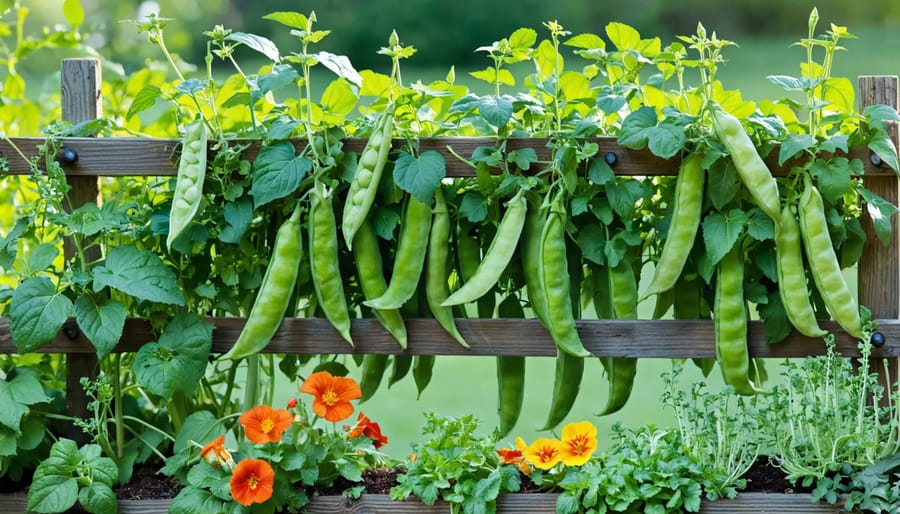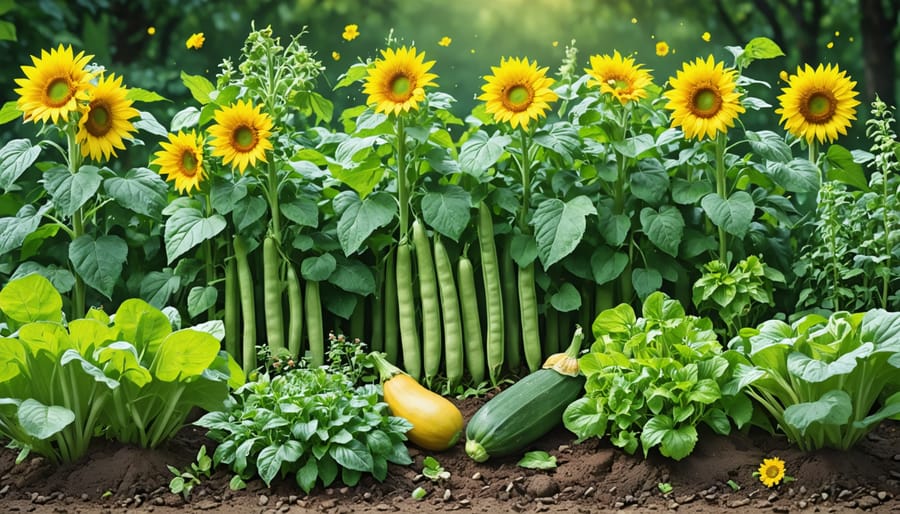Plant fennel strategically in dedicated garden sections to prevent it from inhibiting growth in neighboring plants. This distinctive herb, while excellent to improve soil health naturally, requires thoughtful companion planting due to its allelopathic properties. Pair fennel successfully with robust Mediterranean herbs like dill and cilantro, which share similar growing conditions and complement each other’s growth patterns. Group flowering companions like cosmos and chamomile nearby to attract beneficial pollinators while maintaining sufficient distance from vulnerable plants like beans and tomatoes. Master gardeners particularly value fennel’s ability to attract beneficial insects and deter common garden pests, making it an essential addition to any well-planned garden ecosystem. Understanding these dynamics transforms fennel from a potentially challenging plant into a valuable garden ally that enhances biodiversity and natural pest control.
Understanding Fennel’s Impact on Soil
Beneficial Root Systems
Fennel’s impressive root system plays a vital role in improving your garden’s soil structure. These hardy plants develop long taproots that can extend several feet into the ground, creating natural pathways for water and nutrients to penetrate deeper soil layers. As these roots grow and eventually decompose, they leave behind channels that enhance soil aeration and drainage.
The extensive root network also helps prevent soil erosion by holding the earth together, particularly on slopes or in areas prone to water runoff. Additionally, fennel roots secrete beneficial compounds that can help break down compacted soil, making it easier for neighboring plants to establish their own root systems.
What’s particularly fascinating is how fennel’s roots interact with beneficial soil microorganisms. These relationships help create a healthier soil ecosystem, improving nutrient availability for surrounding plants. However, remember that these powerful roots are also why fennel needs careful placement in your garden, as they can compete with nearby plants for resources.
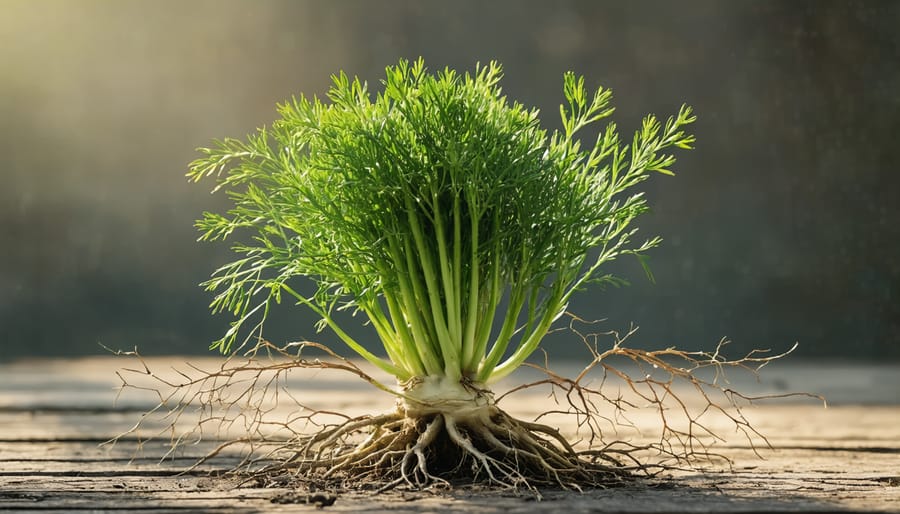
Natural Soil Enhancement
Fennel’s deep taproot system plays a crucial role in naturally enhancing soil quality. As these roots penetrate deep into the earth, they help break up compacted soil, creating channels for water and air to reach deeper soil layers. This process improves drainage and soil structure, benefiting neighboring plants.
When fennel leaves fall and decompose, they add valuable organic matter to the soil, enriching it with essential nutrients. The plant is particularly effective at accumulating potassium and phosphorus from deeper soil layers, making these nutrients more accessible to shallow-rooted companion plants.
The plant’s abundant foliage also serves as natural mulch when trimmed, helping to retain soil moisture and suppress weed growth. Additionally, fennel’s aromatic compounds, released through its roots, can help stimulate beneficial microbial activity in the soil, creating a healthier growing environment for your entire garden.
For best results, consider rotating your fennel plantings annually to allow different areas of your garden to benefit from these soil-enriching properties.
Best Companion Plants for Fennel
Complementary Root Vegetables
While fennel can be a challenging companion plant for many vegetables, certain root vegetables actually thrive in its presence. Onions and garlic are particularly compatible with fennel, as they share similar growing conditions and can help deter pests from each other. The strong aromatic properties of both plants create a natural pest barrier while allowing their roots to develop without competition.
Beets also make surprisingly good neighbors for fennel. Their deep root systems grow at different depths, minimizing competition for nutrients and water. Many gardeners have reported improved flavor in their beets when grown alongside fennel, though this observation is largely based on personal experience rather than scientific studies.
Parsnips are another root vegetable that can coexist peacefully with fennel. These two plants have different maturation times, which means they’re not competing for resources at the same critical growth periods. The key to success is spacing them properly – allow at least 12 inches between fennel and parsnips to give both plants enough room to develop their root systems.
Remember to rotate your root vegetables yearly, even when growing them with fennel. This practice helps prevent soil depletion and reduces the risk of disease buildup in your garden beds. Also, ensure all root vegetables receive adequate water, as fennel can sometimes create slightly drier soil conditions in its immediate vicinity.
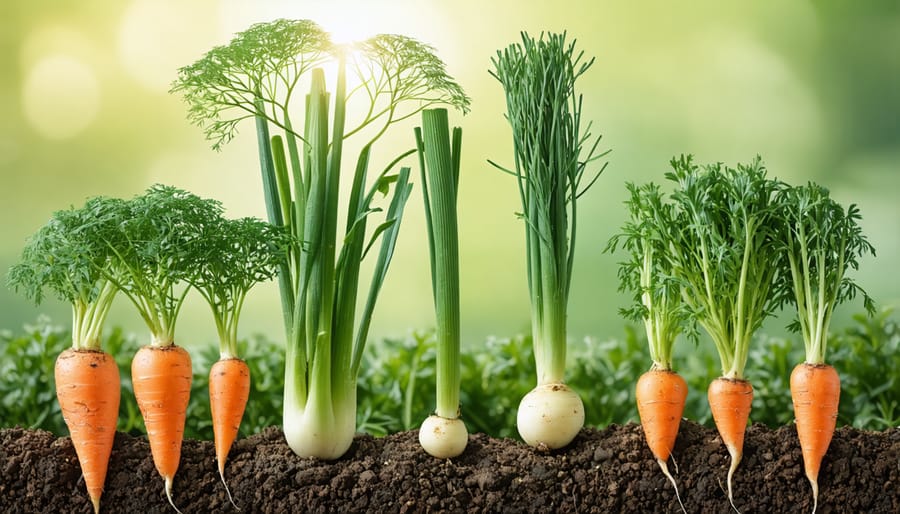
Beneficial Herbs and Flowers
While fennel can be tricky to companion plant, several herbs and flowers actually create wonderful partnerships with this aromatic plant. Dill shares similar growing requirements and can thrive alongside fennel, though you’ll want to keep them at opposite ends of your herb garden to prevent cross-pollination if you’re saving seeds.
Mint makes an excellent companion, as its strong root system helps prevent soil erosion while adding beneficial organic matter to the soil. Just remember to plant mint in containers to prevent it from spreading too aggressively. Calendula flowers not only add beautiful splashes of orange and yellow to your garden but also help improve soil health by attracting beneficial insects and adding nutrients when their petals decompose.
Another fantastic pairing is borage, whose deep roots help break up compacted soil and bring nutrients to the surface where fennel’s roots can access them. The bright blue flowers also attract pollinators, benefiting your entire garden. Consider adding chamomile nearby, as it produces compounds that can help strengthen neighboring plants and improve their essential oil content.
For optimal results, plant these companions about 12-18 inches away from your fennel to give everyone enough room to grow while still allowing their beneficial interactions to take place. This spacing also ensures good air circulation, reducing the risk of fungal diseases.
Plants to Avoid Near Fennel
While fennel adds a lovely flavor to our kitchen gardens, it’s important to know which plants to avoid pairing together to ensure a thriving garden. Fennel can be quite the challenging neighbor, as it releases compounds that inhibit the growth of several common garden plants.
Keep fennel away from beans, tomatoes, and peppers, as these vegetables often struggle when planted nearby. The same goes for kohlrabi, carrots, and cilantro – these plants tend to have stunted growth when fennel is present. Perhaps most surprisingly, other herbs in the carrot family, like dill, caraway, and coriander, should also be planted far from fennel, as they can cross-pollinate and produce less-than-desirable hybrid seeds.
Bush and pole beans are particularly sensitive to fennel’s presence, often showing reduced growth and lower yields when planted too close. If you’re growing peas, keep them well separated from fennel beds, as they also tend to perform poorly when these plants are neighbors.
To keep your garden healthy and productive, consider creating a dedicated herb section for your fennel, keeping it at least 3-4 feet away from these sensitive plants. This approach allows you to enjoy both fennel and your other garden favorites without compromising either’s growth potential.
Remember, while fennel might not play well with certain plants, it still has its place in a well-planned garden. The key is thoughtful placement and spacing.
Planting and Maintenance Tips
Spacing and Layout
When planting fennel in your garden, proper spacing is crucial for both the fennel’s development and its soil health benefits. For optimal results, space fennel plants 12-18 inches apart in rows that are 24-30 inches from each other. This optimal companion planting spacing allows the plants’ root systems to spread naturally while maintaining healthy soil structure.
Remember that fennel’s extensive root system needs room to develop without competing with neighboring plants. This spacing also ensures proper air circulation, reducing the risk of fungal diseases and promoting beneficial microbial activity in the soil. As fennel grows quite tall, this generous spacing prevents overcrowding and allows sunlight to reach all parts of the plant.
In raised beds or container gardens, you can slightly reduce the spacing to 10-12 inches, but be mindful that crowding may affect the bulb development and the plant’s ability to contribute to soil health through its root system and natural compounds.
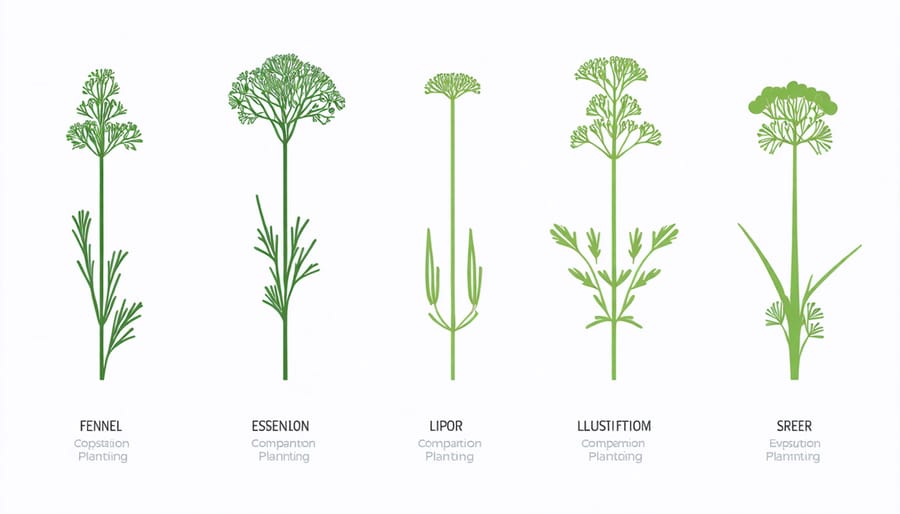
Seasonal Care
To maintain healthy soil when companion planting with fennel, rotate its location annually to prevent nutrient depletion. In spring, prepare the soil by adding well-rotted compost and maintaining a slightly alkaline pH between 6.5-7.0. During summer, mulch around fennel and its companions with straw or dried grass clippings to retain moisture and suppress weeds.
Monitor soil moisture throughout the growing season, keeping it consistently damp but not waterlogged. In fall, after harvesting fennel, plant a cover crop like clover in its previous location to replenish nitrogen levels. This practice helps maintain soil structure and feeds beneficial microorganisms.
Consider adding a layer of leaf mulch in winter to protect the soil ecosystem. When spring returns, incorporate any remaining organic matter into the soil before starting the new planting cycle. Remember that healthy soil leads to stronger plant partnerships and better overall garden productivity.
Companion planting with fennel offers a fascinating blend of challenges and rewards for any garden enthusiast. While it requires careful planning due to its allelopathic properties, fennel can become a valuable addition to your garden when paired thoughtfully with compatible plants. Not only does it attract beneficial insects like butterflies and ladybugs, but it also adds architectural interest with its feathery foliage and distinctive yellow blooms.
Remember that successful companion planting is about observation and adaptation. Start small by incorporating fennel into one section of your garden, perhaps alongside dill or other members of the carrot family. Monitor how your plants interact and adjust your planting scheme accordingly. The beauty of gardening lies in this continuous learning process.
As you experiment with fennel in your garden, you’ll discover its unique contributions to your ecosystem. From providing shelter for beneficial insects to adding depth to your culinary herb collection, fennel can enhance both the productivity and beauty of your garden space. Don’t be discouraged by its selective nature – embrace the challenge and enjoy the journey of creating a harmonious garden environment where fennel can thrive alongside its carefully chosen companions.


